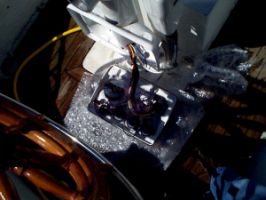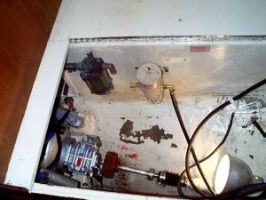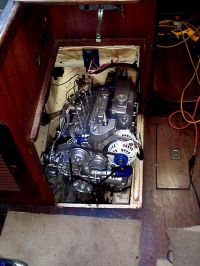

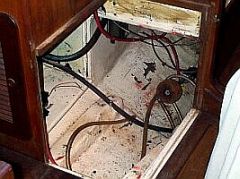 When I purchased the then ANDANTE, I had doubts about the engine and guessed I would need to replace it at some point. The Westerbeke 30 probably had little maintenence but the mechanic said it should be cleaned up - then change the fluids and it should be fine. The Westerbeke seemed to run well and was quite smooth even with a propeller that was a bit chewed up by electrolysis.
When I purchased the then ANDANTE, I had doubts about the engine and guessed I would need to replace it at some point. The Westerbeke 30 probably had little maintenence but the mechanic said it should be cleaned up - then change the fluids and it should be fine. The Westerbeke seemed to run well and was quite smooth even with a propeller that was a bit chewed up by electrolysis.
Then came the drowning of TATOOSH and that changed everything. Do I a rehablilitate the old engine with the bit of money from insurance - or wait a bit and repower with a lighter and more powerful engine?
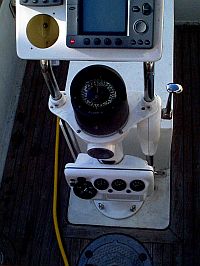 The Phasor P4-37-05 Engine is based on the Kubota block and at 354 lbs. is at least 150 lbs. lighter than the Westerbeke 30. It is lighter but the engine sits lower in the boat which is always a good thing and is narrower than the old engine. Much improved access. Horespower is increased from 28 to 37.5. Then of course there is the custom fitted Balmar Alternator. Probably the biggest thing going for the PHASOR was the customized modular mounts that allowed me to pretty much match the old mounts - and installation was much quicker (and less costly!)using the old engine beds.
The Phasor P4-37-05 Engine is based on the Kubota block and at 354 lbs. is at least 150 lbs. lighter than the Westerbeke 30. It is lighter but the engine sits lower in the boat which is always a good thing and is narrower than the old engine. Much improved access. Horespower is increased from 28 to 37.5. Then of course there is the custom fitted Balmar Alternator. Probably the biggest thing going for the PHASOR was the customized modular mounts that allowed me to pretty much match the old mounts - and installation was much quicker (and less costly!)using the old engine beds.
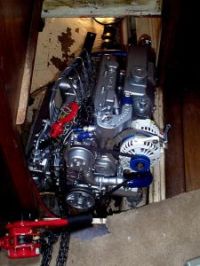 As part of the installation I decided to mount the new engine instruments in a NavPod "Engine Pod" which are made OEM for some of the Catalina models. That decision meant a pedestal and I got a deal from Whitlock on a one that was used for display. A Whitlock single lever throttle and shift control is also mounted on the pedestal - another dramatic improvement over the old Edson two lever controls originally fitted. See Cockpit Changes
As part of the installation I decided to mount the new engine instruments in a NavPod "Engine Pod" which are made OEM for some of the Catalina models. That decision meant a pedestal and I got a deal from Whitlock on a one that was used for display. A Whitlock single lever throttle and shift control is also mounted on the pedestal - another dramatic improvement over the old Edson two lever controls originally fitted. See Cockpit Changes
I had anticipated that the exhaust would be more of a problem. The old exhaust went all the way aft under the fuel tank, up the back of the boat and made a large loop back to the port side of the cockpit and then to an exhaust fitting in a way that was clumsy and kinked the exhaust hose. The kink was noted in the original survey. In looking at that arrangement I decided I could take care of two problems by using a seacock as the exhaust fitting. First, a 90 degree tailpipe will make the run fair and the valve on the exhaust hose is a good thing for passagemaking offshore. An added benifit it the lack of a flanged exhaust fitting to cause a bit of drag when heeled sharply to port. A regular through hull fitting has a nice rounded profile. I of course assume the exhaust hose had to follow this same route.
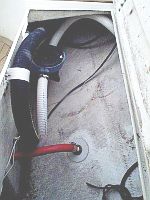 The electric and manual bilge pump hoses (1 1/8 & 1 1/2 inches I.D.) also went under the fuel tank and the new exhaust hose was 2 inches I.D - room was tight. I did not like the long run of the electric bilge pump and felt the hose should also have a vented loop. I found away to reroute the hose under the chart table so it no longer went under the fuel tank which made the actual hose run a bit shorter and I installed a vented loop to prevent back siphoning.
The electric and manual bilge pump hoses (1 1/8 & 1 1/2 inches I.D.) also went under the fuel tank and the new exhaust hose was 2 inches I.D - room was tight. I did not like the long run of the electric bilge pump and felt the hose should also have a vented loop. I found away to reroute the hose under the chart table so it no longer went under the fuel tank which made the actual hose run a bit shorter and I installed a vented loop to prevent back siphoning.
I provided the 2" Conbraco Apollo seacock, tail piece and through hull to the boat yard and had installed a 6" port in the cockpit seat to allow access to the valve. Instead of following the old route the yard chose to route the hose under the fuel tank and then out to the port cockpit locker and then to the seacock. This route puts the exhuast hose over the Whale Titan Bilge pump I installed shortly after purchasing the boat. A much shorter route and the tailpiece points forward - not aft as I originally planned!
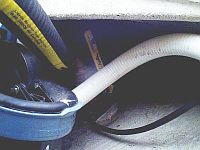
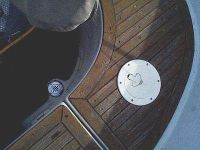
 PHASOR custom fitted the 85 amp. Balmar alternator with a nice stainless steel bracket. I decided to add on a Balmar Max Charge regulator to get the best from it. The very basic regulator originally wired to the alternator has been kept as a spare.
PHASOR custom fitted the 85 amp. Balmar alternator with a nice stainless steel bracket. I decided to add on a Balmar Max Charge regulator to get the best from it. The very basic regulator originally wired to the alternator has been kept as a spare.
The old batteries were barely alive in California and the late winter trek across the country did them in finally. New starting battery is an Optima spiral cell AGM which is mounted under the chart table - so there is a nice short run to the engine. New ahouse batterues are also being instaled behind the engine. This of course means a whole lot of rewiring .....
